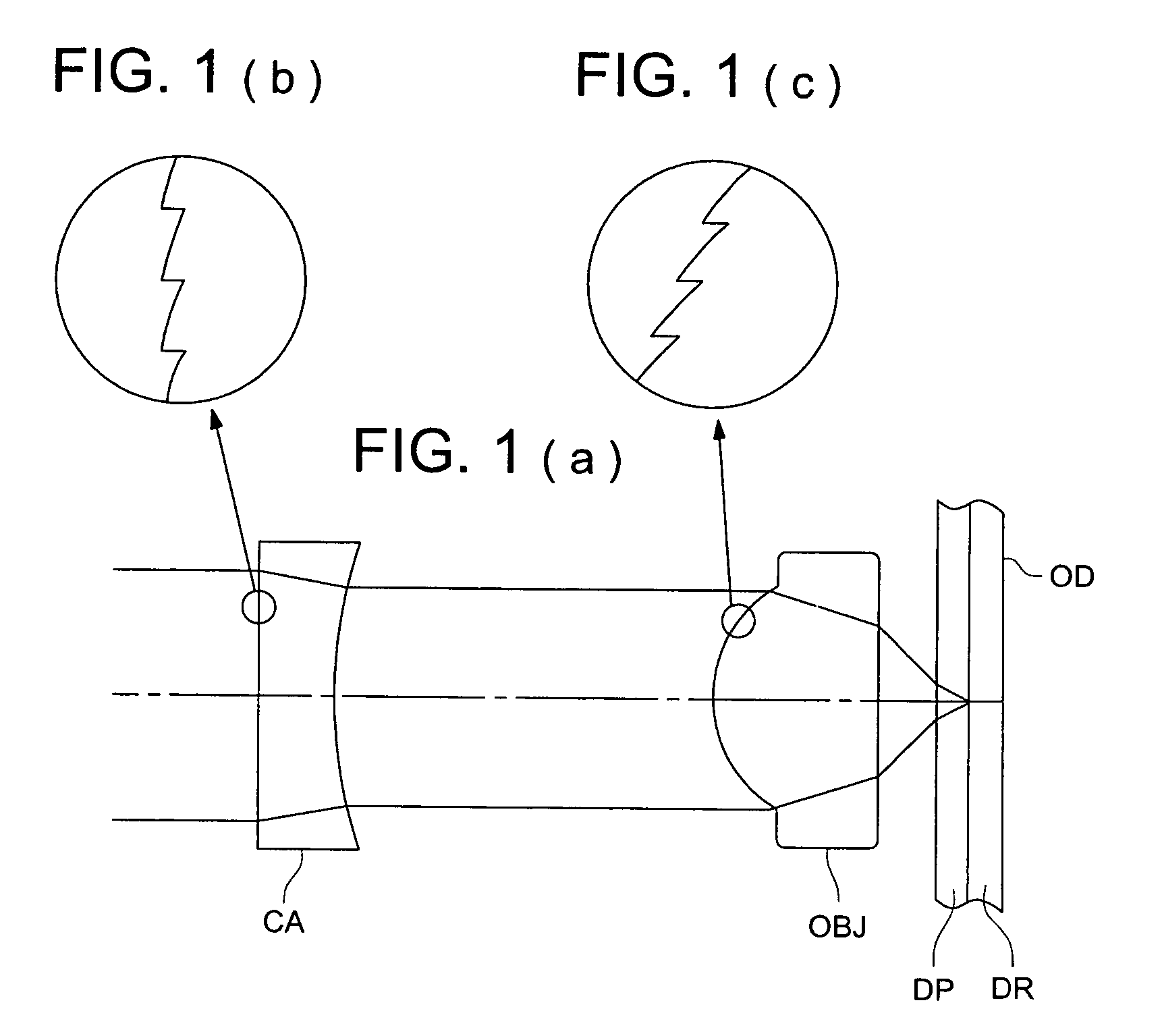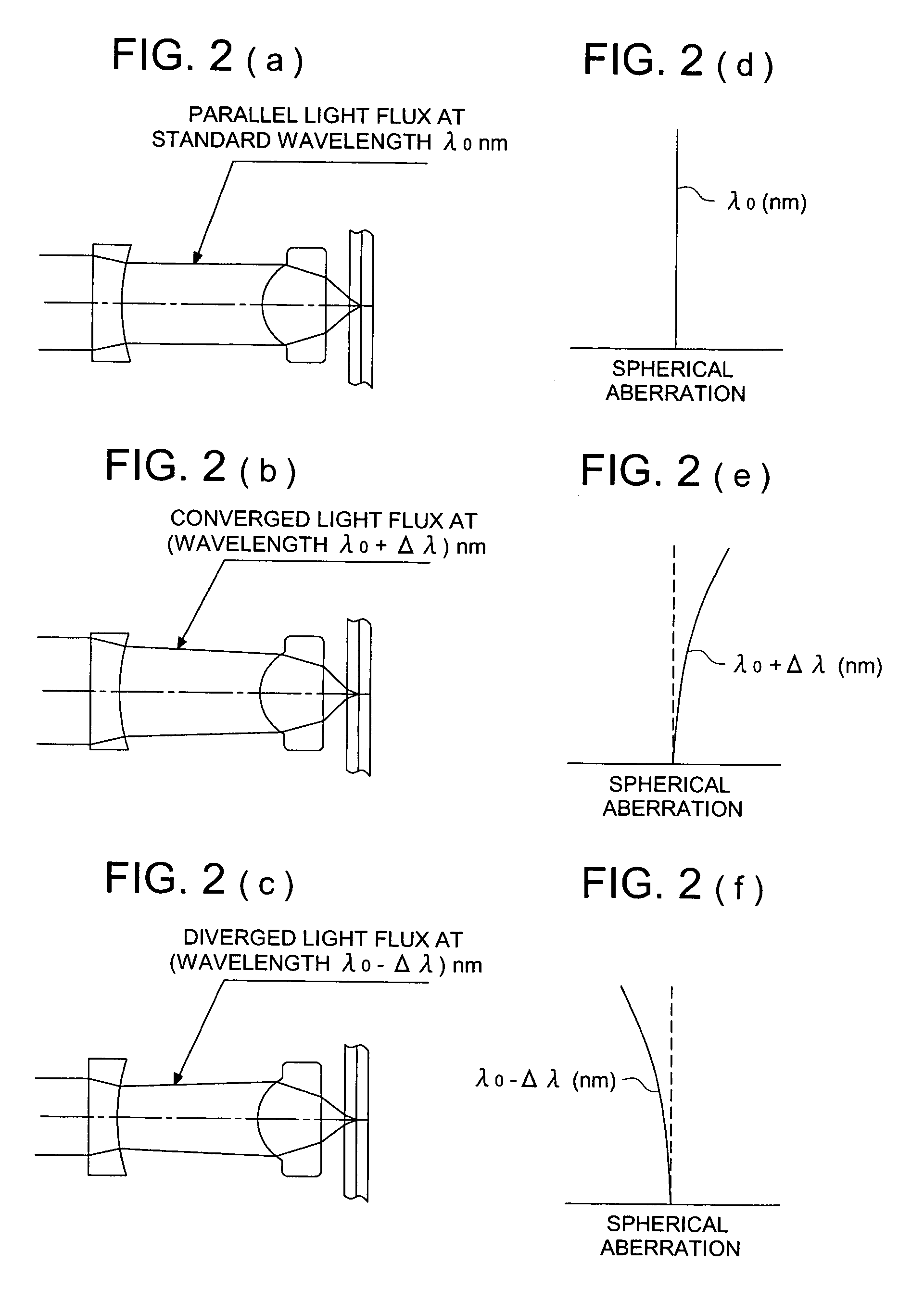Objective lens, optical system and optical pickup apparatus
- Summary
- Abstract
- Description
- Claims
- Application Information
AI Technical Summary
Benefits of technology
Problems solved by technology
Method used
Image
Examples
example 1
[0141]Lens data of the optical system for an optical pickup device in Example 1 are shown in Table 1. The present example is one preferable as optical system OS for an optical pickup device shown in FIG. 1, and it is composed of objective lens OBJ and of chromatic aberration correcting element CA arranged between parallel light fluxes between the objective lens OBJ and the light source. Both of the objective lens OBJ and the chromatic aberration correcting element CA represent a plastic lens. Incidentally, the chromatic aberration correcting element CA is designed so that it may have no aberration within a diameter of 3.4 mm on its surface where a light flux emerges (Second surface in Table 1).
[0142]
TABLE 1SurfaceNo.r(mm)d(mm)NλνdRemarks0∞Light source1∞1.00001.5243256.5Chromatic aberration2 10.57935.0000correcting element3 0.94201.79001.5597356.3Objective lens4 −1.56000.39515∞0.08751.6184930.0Protective layer6∞
[0143]
Coefficient of aspheric surfaceSecond surfaceThird surfaceFourth...
example 2
[0155]Lens data of the optical system for an optical pickup device in Example 2 are shown in Table 2. The present example is one preferable as optical system OS for an optical pickup device shown in FIG. 1, and it is composed of objective lens OBJ and of chromatic aberration correcting element CA arranged between parallel light fluxes between the objective lens OBJ and the light source. Both of the objective lens OBJ and the chromatic aberration correcting element CA represent a plastic lens. Incidentally, the chromatic aberration correcting element CA is designed so that it may have no aberration within a diameter of 3.4 mm on its surface where a light flux emerges (Second surface in Table 2).
[0156]
TABLE 2SurfaceNo.r(mm)d(mm)NλνdRemarks0∞Light source1∞1.00001.5243256.5Chromatic aberration2 10.57935.0000correcting element3 0.93911.78501.5597356.3Objective lens4 −1.58470.39505∞0.08751.6184930.0Protective layer6∞
[0157]
Coefficient of aspheric surfaceSecond surfaceThird surfaceFourth...
example 3
[0169]Lens data of the optical system for an optical pickup device in Example 3 are shown in Table 3. The present example is one preferable as optical system OS for an optical pickup device shown in FIG. 1, and it is composed of objective lens OBJ and of chromatic aberration correcting element CA arranged between parallel light fluxes between the objective lens OBJ and the light source. The objective lens OBJ is a glass lens having glass transition point of 285° C. (PG 325 made by SUMITA Optical Glass Co.), while, the chromatic aberration correcting element CA is a plastic lens. Incidentally, the chromatic aberration correcting element CA is designed so that it may have no aberration within a diameter of 3.4 mm on its surface where a light flux emerges (Second surface in Table 3).
[0170]
TABLE 3SurfaceNo.r(mm)d(mm)NλνdRemarks0∞Light source1∞1.00001.5243256.5Chromatic aberration2 13.45425.0000correcting element3 0.90191.78001.5184370.5Objective lens4 −1.26660.40665∞0.08751.6184930.0...
PUM
 Login to View More
Login to View More Abstract
Description
Claims
Application Information
 Login to View More
Login to View More - R&D
- Intellectual Property
- Life Sciences
- Materials
- Tech Scout
- Unparalleled Data Quality
- Higher Quality Content
- 60% Fewer Hallucinations
Browse by: Latest US Patents, China's latest patents, Technical Efficacy Thesaurus, Application Domain, Technology Topic, Popular Technical Reports.
© 2025 PatSnap. All rights reserved.Legal|Privacy policy|Modern Slavery Act Transparency Statement|Sitemap|About US| Contact US: help@patsnap.com



